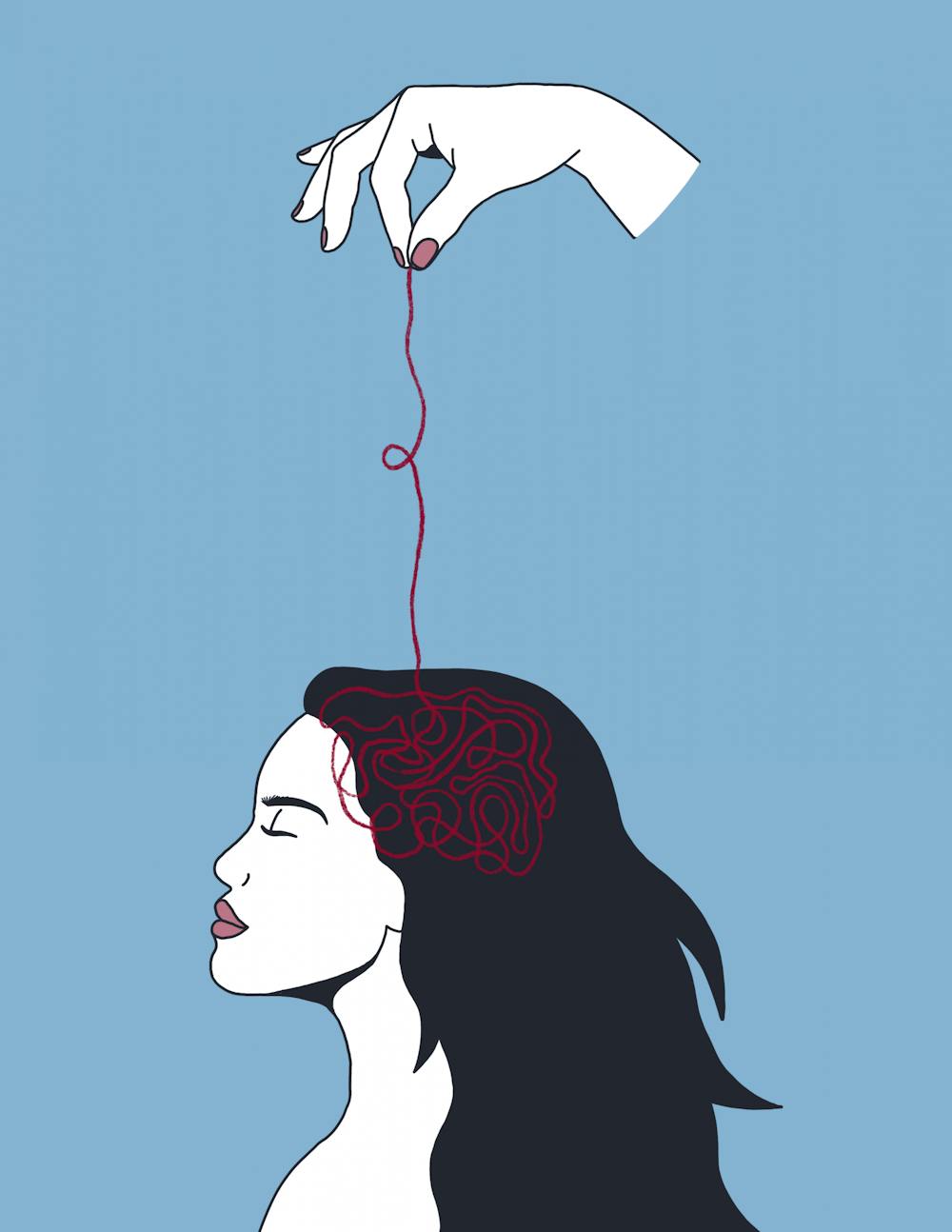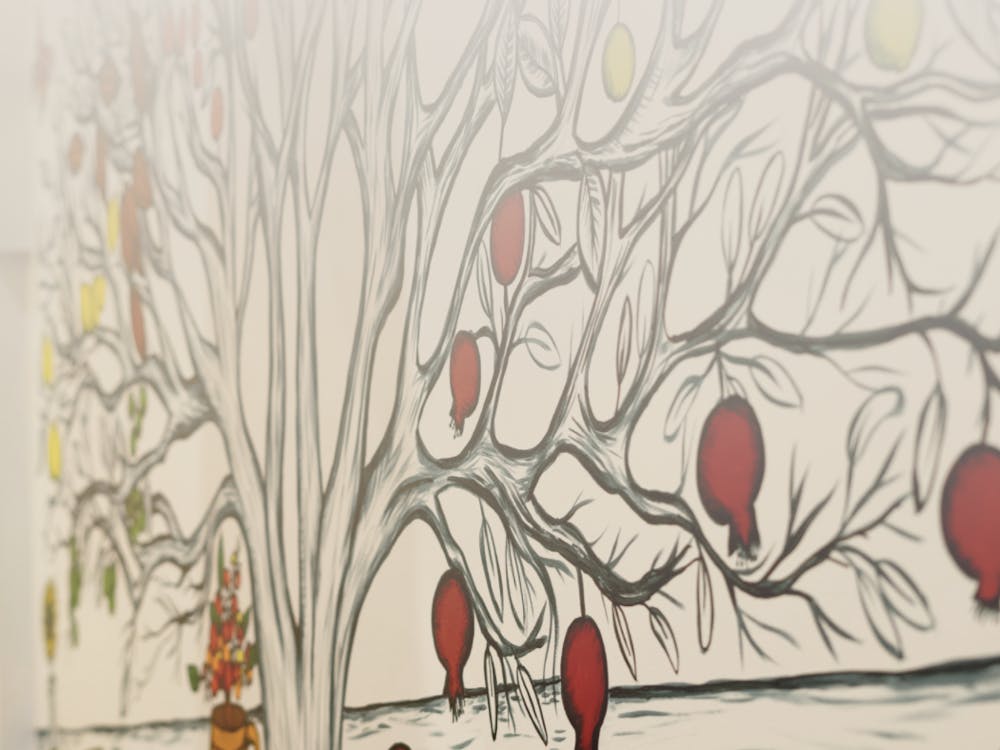When do the issues that are solely considered mental health problems reveal larger, institutional problems at play? Some may argue that if everyone needs a therapist, larger social problems are accountable — not just mental health problems themselves.
With the recent opening of the new Student Health Center this fall, University-provided mental health resources and programming have been expanded to include three additional group therapy rooms, a dedicated art therapy space, and an area for “mind-body programming,” such as acupuncture and biofeedback. The University has also launched access to TimelyCare, a mental health support interface that provides all students with 12 free counseling visits with a licensed mental health provider, access to psychiatric care and access to TalkNow, an on-demand service which allows students to connect freely with health professionals at any time of day.
Despite these expansions, students continue to demand more mental health support. Young Democratic Socialists of America at U.Va. launched a campaign in September calling for the University to expand how long and easily students can access services without extensive waitlists or limited visiting periods to CAPS and the Maxine Platzer Lynn Women’s Center.
Third-year College student Aubrey said she feels as though mental health care at the University lacks personalization.
“It's very mechanized,” Aubrey said.
Aubrey explained that when she was struggling and reached out for help, she felt as though Counseling and Psychological Services just wanted to get her through the system so they could check a box.
“If you're struggling, they just want to offer you resources in the easiest way possible,” Aubrey explained.
Both students and the University recognize the importance of mental well-being, but the University’s ability to care for the mental health of its students continues to be called into question. Why exactly do students need these services in the first place? What social and institutional stressors are placed on University students, and in what ways do these examples fail to encompass all of the potential causes and solutions to student mental health?
The “work hard, play hard” mentality
Business Insider has named the University one of the smartest party schools and most intense colleges, meaning that the school maintains a strong “work hard, play hard” culture. From Monday to Friday, students stress over exams, papers and classes, while on the weekend students enjoy themselves at parties and bars. Aubrey described the typical, picture-perfect University student as someone who is on top of all their assignments, taking a heavy course load, and active in multiple clubs, all while having a thriving social life and positive attitude. Many University students share similar yet false conceptions about the “typical” University student.
“Work hard”
One big motivator for academic performance at the University is competitive application-based majors and clubs in which only a certain number of students are selected, such as students who apply to the Frank Batten School of Leadership and Public Policy and McIntire School of Commerce. Majors like Global Public Health, Media Studies, Political and Social Thought and various distinguished majors programs also require applications, however. For all of these programs, applicants must submit essays, a transcript and a resume — the application for Batten also requires letters of recommendation.
Students also go through application processes and interviews for popular clubs at the University too. For example, getting involved with popular groups like the Honor Committee, the University Judiciary Committee, the Jefferson Literary and Debating Society and the University Guide Service requires an application or interview process — and sometimes, both.
Many groups argue that this application process fosters unique communities, and for the application-based majors, access to more individualized attention and additional resources like seminars. Some, however, say that the number of applications and interviews required for clubs, majors and research creates a toxic environment of competitiveness among students. Application-based programs also limit accessibility for students that may not have the time or resources to apply to a major or club, in turn causing more stress and anxiety.
Aubrey talked about her own experiences of rejection during her time at the University.
“When you don't get into something, you compare yourself to other people and think, ‘is there something wrong with me?” Aubrey said.
Aubrey said she thinks competitiveness stemming from applying to majors and clubs is not often talked about because it is just accepted as the norm.
“It's just how things are,” Aubrey said.
Stella Connaughton, fourth-year Batten student and senior counselor for UJC, said she thinks UJC’s application process creates a competitive culture that often leads to anxiety or stress for students undergoing the process. In her own personal experience joining UJC, Connaughton said she found the process intimidating.
“I’m a first-generation, low-income college student, so I definitely had to deal with a culture shock when I came here, especially because we see that student self-governance is predominantly wealthy and white,” Connaughton said.
Connaughton said she thinks clubs like UJC can be elitist due to their application-based nature.
“There’s an interview process, and you have to wear a suit — some kids don’t have access to suits,” Connaughton said. “It’s also a big time commitment.”
Connaughton added that UJC does try its best to make the application process take up as little time as possible, through a short application that requires only about 700 words of writing, and an interview that takes only 15 minutes.
“I [don’t] think the entire application process would take more than two hours for both written and interview,” Connaughton said.
In addition, UJC does not look for particular “professional” traits that might make the selection of students elitist.
“Professionalism can be very subjective,” Connaughton said. “We don't necessarily look for them having the right answer, we actually look at multiple facets of a person and we can identify if they have characteristics that would make them a good counselor.”
“Play hard”
Each weekend, students can be found going out to parties and frequenting bars on the Corner. While going out can be a way to release stress after a long week, partying and drinking culture can also be a distraction from responsibilities such as school and extracurriculars. Partying culture can also take a toll on physical health — and mental health by extension.
“I understand that party culture helps a lot of people break out of their shell and that it can be a good distraction from how hard school actually is,” Aubrey explained.
Still, Aubrey expressed that sometimes, this culture can get overwhelming.
“If you're chronically using drinking and partying to fix all of your problems, that's where the intersection between school life and weekend life can get dangerous,” Aubrey said.
There is also a concern that students may rely on substances like alcohol or drugs to manage mental health issues like anxiety or stress. However, the University has support networks and programs for these students with substance-reliance problems. The University’s Gordie Center focuses on limiting the consequences of fraternity hazing while the University’s Hoos in Recovery program offers support for students in recovery or considering recovery from substance abuse disorders.
Resident life
The Housing and Residence Life staff includes 240 students who oversee on-Grounds living and learning, but the nature of their jobs often makes them the most averse to mental health stressors.
“Resident staff are put in a position where we’re supposed to provide help and support for our residents, while at the same time supporting ourselves,” said Jayla Hart, fourth-year College student and co-chair of Housing and Residence Life.
Hart was a resident advisor during her second and third year, before becoming the co-chair of the group earlier this year along with fellow fourth-year College student Mj Smith.
“Even though I knew that there were people that I could talk to, I wasn't always sure about the best [method] of communicating the troubles that I was having, whether that was with my residents or just the school more broadly,” Hart said.
The pandemic in particular has placed stressors on resident staff, Hart said. Last year, with strict health and safety measures in place, resident staff were expected to enforce social distancing and masking rules more often than they were expected to engage with their residents.
“It just felt like everything was happening at once in a lot of ways,” Hart said. “The University was changing policy and not effectively communicating those policy changes to resident staff in advance. We were expected to police our [resident] areas in ways that we aren't comfortable doing.” Hart emphasized that this caused a lot of mental pressure and worry for resident staff.
Hart also explained the importance of setting boundaries in order to protect one’s own mental health. She explained that students — particularly resident staff — need to set boundaries in order to care for themselves first so they are able to fulfill other responsibilities and care for others. According to Hart, HRL has been stressing the importance of self care and community care this past year.
“If you're having a bad day, how do you communicate that to your residents?” Hart said. “How do you tell your SR? How do you check in with yourself and be honest about the fact that it's okay to admit that you're overwhelmed?”
Fortunately, HRL has additional built-in mental health resources for resident staff.
“We have a CAPS specialist, and we can reserve time to go meet with her,” Hart explained. “The University has also expanded telehealth counseling and psychiatry for us as well. We’re definitely seeing a push to take our mental health concerns more seriously, especially since my first year in the program.”
In addition, RAs have weekly check-ins with the building’s senior resident, which allows them to touch base and talk about how they are feeling. These check-ins also allow senior residents to point their resident advisors to additional mental health resources, like scheduling an appointment with CAPS.
Despite an increase in attention to mental health, Hart mentioned that there remain problems to be addressed.
“I think people are still struggling and I know especially coming into this semester, I struggled even before residents came with having all the RAs back on Grounds and keeping them safe,” Hart said. “There is so much work surrounding mental health — now and in the future — that still needs to be done. We have to keep growing the ways in which we think about care at this university, both within resident staff and just across the community at large.”
Hart expressed excitement for the new Student Health building.
“Watching the expansion of mental health services really excites me because I think that there will be [a lot more] mental health support for all people, not just resident staff,” Hart said. “I'm hopeful that we’ll see more creative ways of supporting people.”
Hart continued that this includes programming that includes a “wide variety of resources that students and faculty can do to take earnest care of themselves.”
Pressures of a predominantly white institution
Students of color face a specific set of mental health challenges separate from their white classmates. The University is a predominantly white institution, meaning that white students account for at least 50 percent of the population. The University undergraduate body as of 2019 is 55 percent white, 16 percent Asian American, 6.74 percent African American and 6.73 percent Hispanic.
The impact of attending a PWI can have a multitude of effects on the mental health of students of color. Professor Noelle Hurd, a professor in the Psychology Department here at the University studies experience of marginalized groups at schools and universities.
“Students who belong to groups that are underrepresented in higher education are more likely to encounter discrimination and messages of exclusion at historically and predominantly white colleges and universities,” she said in an email to The Cavalier Daily.
Hurd added that these messages of exclusion can “cause them to experience stress and symptoms of anxiety and depression.”
Asst. Psychology Prof. Seanna Leath said there is a need for more resources to support students of color, particularly Black students. Leath explained that these students often do seek out mental health support at their universities, but often experience “longer wait times for them to actually be seen by clinician, or [when] they were actually seen by a clinician, they felt like their counselor couldn't understand the issues they were bringing to them, whether they were race related or otherwise.”
Leath said there is often a “cultural or racial dissonance” for students of color seeking a counselor's support.
“If students feel a disconnect with who they were talking to, they may decide not to go back because they don’t think it will actually be helpful,” Leath said.
As such, it is important that predominantly white institutions like the University actively hire more people of color for their counseling staff, Leath said.
“Institutions need better representation of marginalized groups at all levels (students, faculty, and staff) such that being at the institution is not such an isolating experience for marginalized students,” Professor Hurd wrote.
Leath also discussed the importance of creating spaces specifically for students of color on Grounds, as a lack of these spaces “reinforces the notion that this campus is for everyone but them.” These spaces can be occupied by other students, but people just need to be “mindful of how they occupy space,” Leath said.
“We often see that there can be less funding for Black student organizations or organizations for students of color,” Leath said. “Universities will specifically give money more often for one off events, a one time thing, but they don't give money to start any kind of legacy. We need more funding for a pipeline program of some sort that will continue for years down the line.”
In recognition of this failure, Student Council began offering diversity grants for Multicultural CIOs.
Both professors emphasized the need to think outside the box when it comes to mental health solutions. For everyone — students of color included — getting help does not necessarily mean going to therapy. “We need to broaden our focus on how we promote student wellness, beyond just sending students to CAPS or another counseling center,” Leath said. Both Leath and Hurd pointed to more community centered support and assistance.
Leath conducted a study at the start of the pandemic, which highlighted how many students were coming together and connecting with one another to bridge social isolation and improve their own mental wellbeing. “Students were talking about all the ways they were connecting with their friends and family digitally, which they felt positive about,” Leath said. “Even though they did report increased stress and anxiety, they were also saying, ‘Oh, I'm seeking out support from my friends. We're using Tik Tok and all these other digital platforms to talk to one another and stay connected.’” Leath added that the study’s participants were “thinking very intentionally” about improving their own mental health.
Both professors discussed the importance of peer-to-peer support for students of color arriving on Grounds.
“Peer mentor programs are key in terms of understanding the campus,” Leath said. “It's great to have that kind of insider knowledge. Being connected to other Black students early on is important for their transition.”
Moving forward
The institutional and social influences on mental health at the University are diverse and wide-ranging, and therefore require problem-specific solutions as well. However, this does not mean that the University can’t pursue solutions to unhealthy culture and systems.
“I think if I can trust anything about this University, it is the fact that there is support for your mental health,” Hart said. “Sometimes students think the University is leaving them out to dry, and I want to stress that that isn't entirely true. There definitely are places where we need to improve, but there are resources available. There are people who genuinely want to help all of us.”







